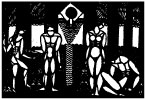The second bill of the 1917-1918 season opened on November 30, 1917 and ran for six performances, and Knot-Holes, written by Bodenheim and Saphier, was the first play presented on the bill. Set on “a road by a graveyard,” the story opens with The Jaunty Bricklayer trying to persuade the Sleepy Mayor to build a brick wall to replace the wooden fence filled with knotholes that is behind the town’s cemetery. The Mayor refuses, telling the Bricklayer that “a wooden fence can be melted by the rain and wind, and sun, until it is covered with an endless whisper. And the knotholes are like pauses in its whispering.”(1) The Bricklayer argues that the Mayor is just being sentimental when two Ghosts appear, dressed in black capes, grey tights, and wide, black-plumed hats, and they leap down from the fence. As figures representing “the romance of the past,”(2) they object to the brick wall because the knotholes in the wooden fence are “tiny windows of our moon-walled house, through which they can sip a second life and watch mothers with children, young lovers and men like the Bricklayer, who are like walking coffins carrying dead children.” They grab the Bricklayer and, by making him dance and spin, they “shake to life the dead child within him.”(3) The Bricklayer changes his mind, deciding he likes the fence, and looks up to see the moon for the first time. The play ends with the Mayor and Bricklayer looking up at the moon, arms around each other like little children.
Murphy sees the wall of the play as “the common World War I figuration . . . to indicate the obstacles that modern social and political structures present to human communication and understanding.”(4) She also points out that Bodenheim and Saphier wrote this long before the psychological concept of the “‘inner child’ became a cultural cliché,” but wanted to communicate the similar idea that it’s “only through the reawakening of a childlike openness to the imagination . . . that this civilization can once again embrace the romance of the past and become open to both human communication and wonder at the beauty of the world.”(5) Murphy wonders that “Bodenheim’s play must have seemed strange to the 1917 audience, particularly in juxtaposition with the rest of the bill . . .”(6) Bodenheim himself played the Mayor; Otto Liveright, in his first role with the Players, played the Bricklayer; and Alice MacDougal and Dorothy Upjohn played the ghosts, their first names abbreviated in the program, perhaps to discourage any gender identification of the Ghosts. No director or set designer is listed, making one surmise that perhaps Bodenheim supervised the production. The costumes were designed by Avrile, the professional name of Edith Unger. Unger was a sculptor who also owned The Mad Hatter, one of the Village’s favorite tea shops, located just below the Samovar on West Fourth Street; this was her first design job for the Players.
© Jeff Kennedy 2007
(1) Maxwell Bodenheim, Knot-Holes, Unpublished Manuscript, Billy Rose Theatre Collection, New York Public Library.
(2) Murphy, Provincetown 3/37.
(3) Bodenheim Knot-Holes.
(4) Murphy, Provincetown 3/37. One notes that this image of a wall is again repeated later in Millay’s anti-war play Aria da Capo.
(5) Murphy, Provincetown 3/38.
(6) Murphy, Provincetown 3/37.
.
